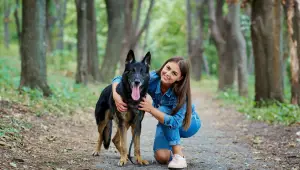For more loose leash walking methods, check out this Loose Leash Walking Bundle of online training courses by SpiritDog Training.
In this article I’ll explain how to use the “300 Peck Method” to get your furry friend to walk nicely on a loose leash.
Dogs are fantastic companions and loose leash walking is a great skill that enables you to get out and about with your dog walking closer to heel for situations where it’s not safe for them to be off leash.
The only problem is that it’s sometimes harder to walk Fido on lead because they naturally move at a much quicker pace than us slowcoach humans.
If your dog tends to pull on the leash, it can be frustrating and tiring. The 300 Peck Method is a great way to help train your dog to walk nicely on a leash.
It’s simple to follow and very effective! Keep reading for more information about the 300 Peck Method and how to use it.
When your pooch pulls on leash this can make walks stressful and a chore.
As a dog trainer, I know it can be a struggle to train your dog how not to pull, but with the right technique, learning loose lead walking can be easy and fun for both you and your pup.
I have a foolproof system that will have Fido walking perfectly like a service dog in no time, using positive reinforcement and without physically punishing them or constantly changing direction.
So what are you waiting for?
Time to put those hindquarters into gear and start teaching Fido some new skills! Trust me, it’s well worth the effort. (:
Teach your dog loose leash walking with the 300 peck method
- Start in a familiar environment with minimum distractions – indoors at home is fine – when you and your dog are happy and relaxed. Make sure they are not too hungry, we’re going for peckish but not starving.
- Have some tasty treats handy in a pocket or treat pouch so you can get them out quickly. Something small with a texture that they don’t have to crunch or chew is ideal – I use sausage, cheese or chicken.
- Start with your pup next to you facing forward, next to your left knee.
- Take one step, say “good” and give them a treat.
- Take two steps, say “good” and give them a treat.
- Continue by adding one step extra between each food reinforcer. If your pup becomes distracted, go back to #3 and start over with one step, “good” reward.
- Try to keep it moving so you are not stopping to reward them next to your knee.
- Count silently in your head, not out loud, otherwise your dog might make the association “When they speak, I walk politely. When they don’t, I can be a yoyo!”
- When rewarding, use your left hand if your pooch is on the left. This means you will need to hold the leash in the opposite hand to the side the dog is on. Treat with your left hand to your left knee so they are not tempted to move across in front of you.
- Whilst we’re not looking for competition style formal heeling, but when it comes to treat delivery and placement, make sure it’s nice and close to your knee.
- In between rewarding your dog, aim to keep your hand on your belly button so your dog isn’t tempted to nudge your palm or jump up.
- Once you and your dog as practiced this in an easier environment you can add a collar or harness and leash and take it out into the big wide world.
- Take normal paced steps to begin with and then once you’ve taught your dog what’s required, you can change the speed.
- Congratulations – you’re now loose leash walking like a pro!
The start of a typical session might look like this:
- Take 1 step, say “good” and reward
- Take 2 steps, “good” and reward
- 3 steps, “good” and reward
- 4 steps, “good” and reward
- 3 steps, dog fails – start over
- 1 step, “good” and reward
- 2 steps, “good” and reward
- 3 steps, “good” and reward
- 4 steps, “good” and reward
- 5 steps, “good” and reward
- 6 steps, “good” and reward
- 3 steps, fail – start over
- 1 step, “good” and reward
- 2 steps, “good” and reward
Remember the hard and fast rules of the technique – go back to the beginning if your dog starts pulling or becomes distracted. If you prefer, you can use a clicker rather than a marker word, so instead of saying “good”, you’d be clicking and treating.
This technique enables us to increase our criteria and start to introduce a variable reinforcement schedule with greater than 80% success rate overall – and we don’t even have to think too much about it! We just remember the number of footsteps and add an extra footstep for the next rep and you will see steady improvement.
This method also helps get the perfect level of rewards to help your dog learn to focus on you. When we are training in a situation that is more distracting, the rate of reinforcement (RoR) needs to be higher to make it easier for the dog to concentrate on what they’re supposed to be doing. When our dogs become distracted and we start again at the beginning, this gives them a better chance of succeeding.
This approach is also great for other behaviours too. This way of training animals was given its name following experiments with pigeons after the birds were trained to peck 300 times before receiving a reward, so your only limit is your imagination! Whatever you’re working on you can always go back to the beginning if they become distracted!
Remember – it’s totally fine if your dog wants to sniff the ground whilst you’re on a walk, as this can help them to stay calm, just make sure the leash is not taut. I like to use a 2 metre training leash so my dog has an opportunity have a bit of a sniff and enjoy their walk.
I hope this technique helps you teach your pooch to walk politely so that you can enjoy getting out and about and be blessed with a stronger bond with your dog!
Check out this post if you’re wondering what are the best dog treats for training when teaching your dog loose leash walking.
For more loose leash walking methods, check out this Loose Leash Walking Bundle of online training courses by SpiritDog Training.







